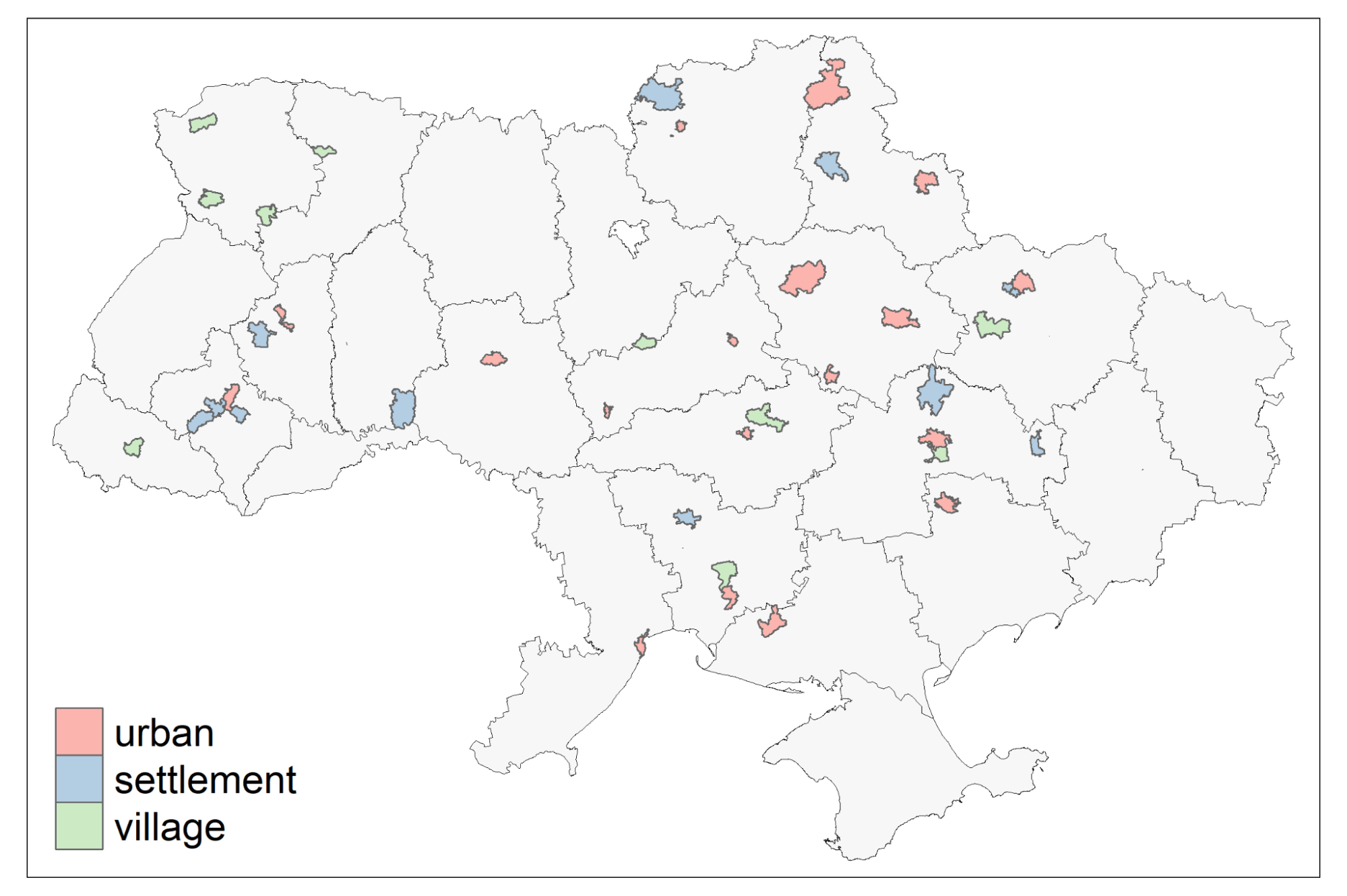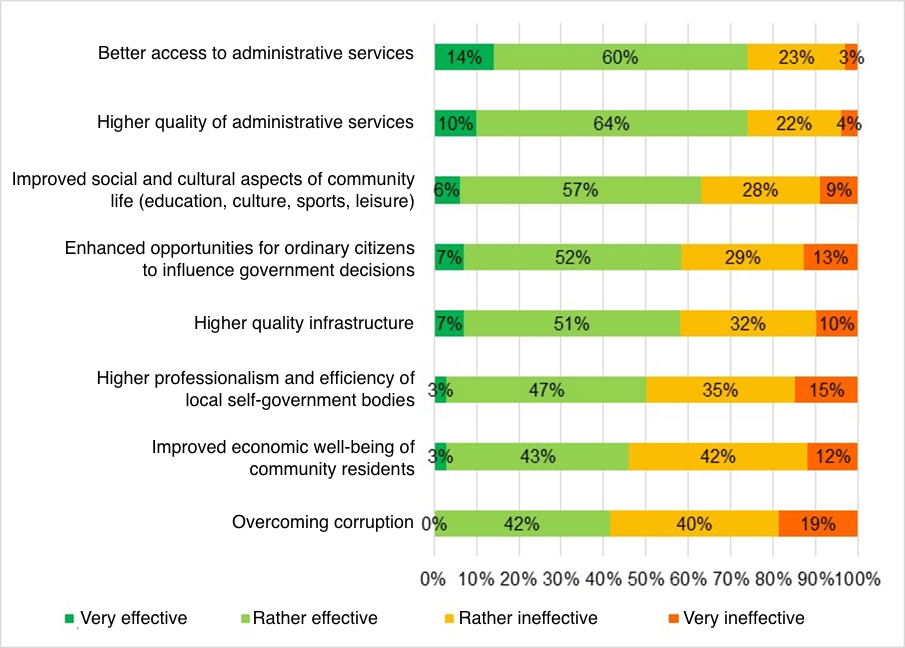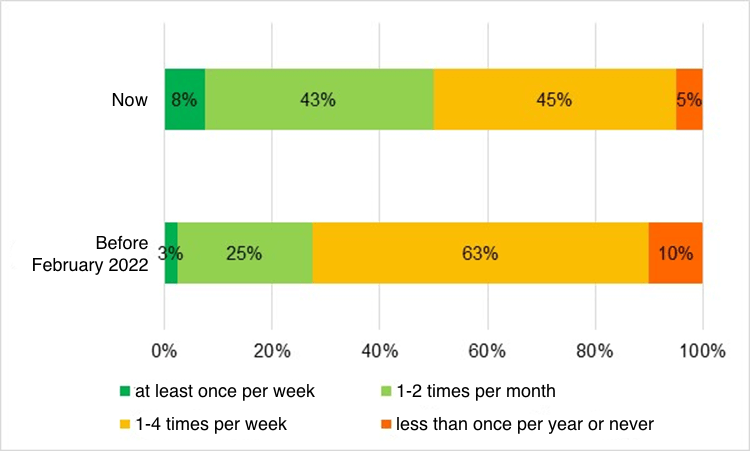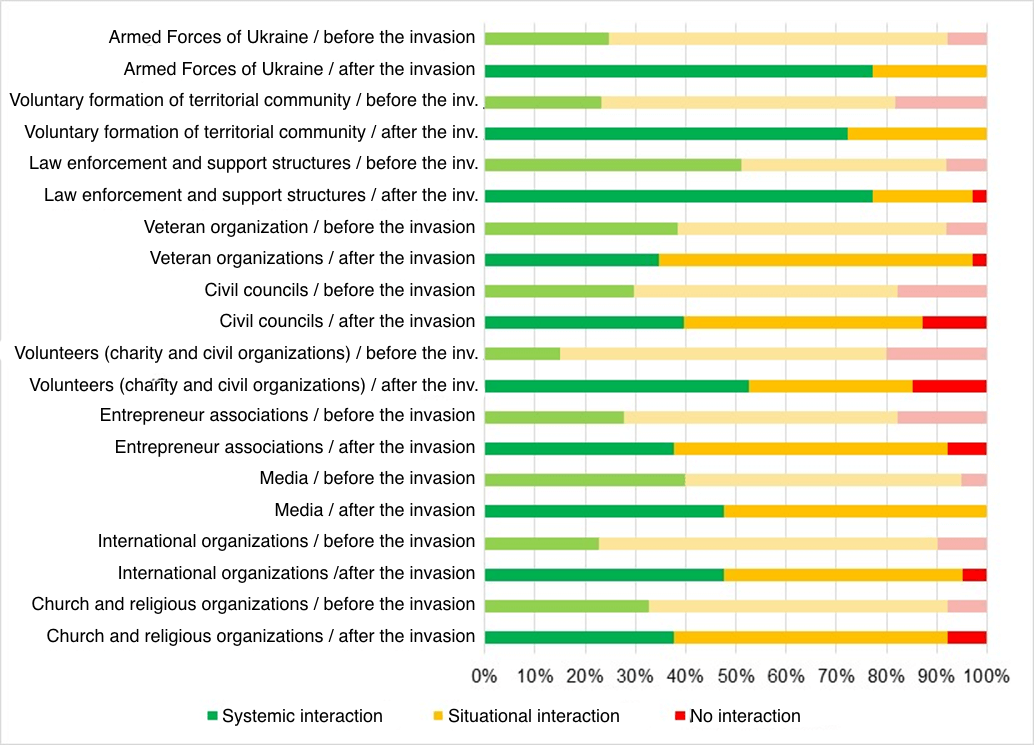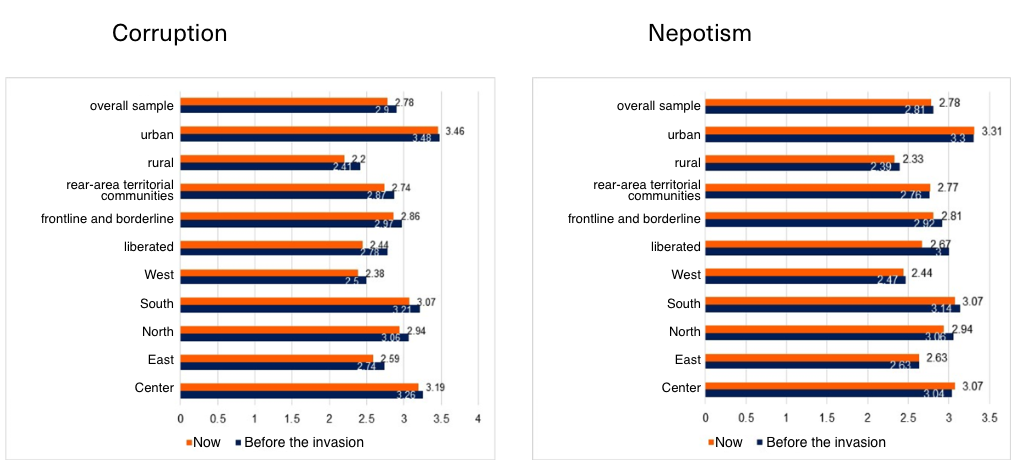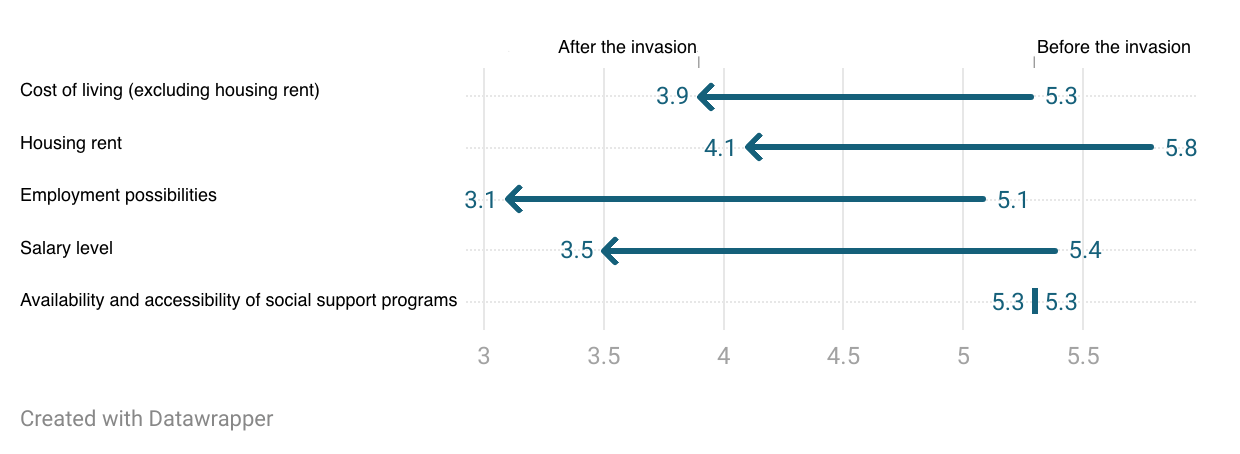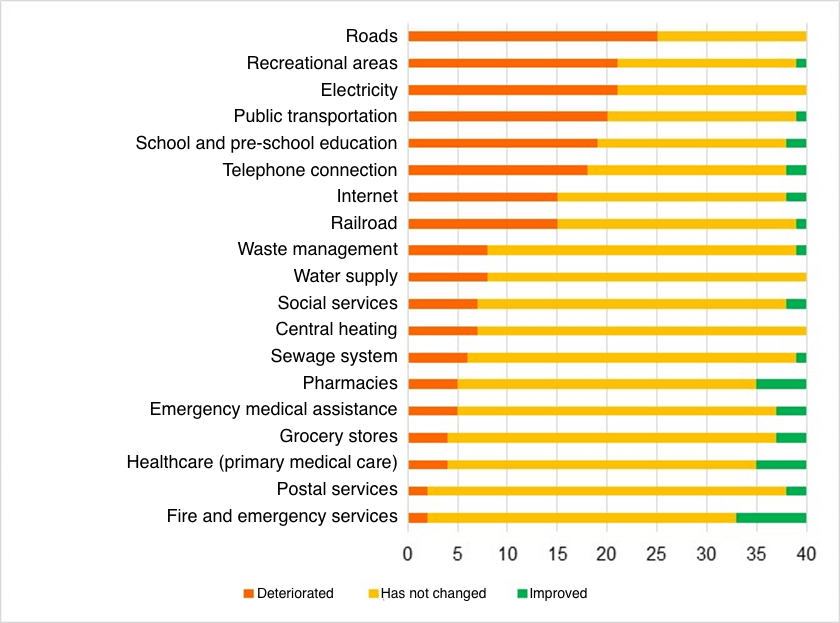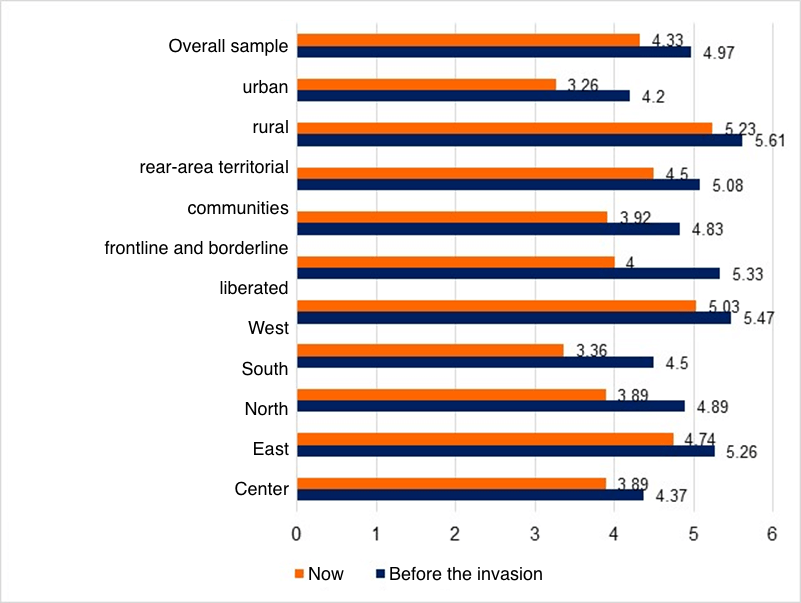General trust and trust in formal institutions is a key enabler for political stability and economic prosperity of modern democracies (Fukuyama, 1996). Trust can also be an important factor in increasing a society’s resilience to major crises (Longstaff and Yang, 2008). The fall of 2023 is remembered by many for a deterioration in the relationship between the population and activists towards local authorities, mass protests in regional centers against the improper use of community funds, and insufficient support for the army. Is there a crisis of trust in local institutions that could affect their resilience? How do activists assess their interaction with local government authorities (LGAs), and did the issues with the authorities only arise in the fall of 2023?
In this article, we present the results of a survey of civic activists and their opinions on interaction with local authorities and trust in them. We demonstrate that since the beginning of the full-scale invasion, the increase in accountability and transparency of local government, as well as citizen engagement in decision-making, has supported trust in local authorities despite worsening economic conditions and ineffective resource allocation within territorial communities (hromadas).
The survey was conducted as part of a collaborative project between the Center for Sociological Research, Decentralization, and Regional Development at KSE Institute and the London School of Economics and Political Science under the PeaceRep program.
Survey design
Our research is not representative, but it highlights the main trends and features of collaboration with authorities in the work of activists.
For our research, we gathered a network of local activists from 40 territorial communities located in 19 different regions across all macroregions of Ukraine (see Map 1) for regular data collection. This approach was chosen for several reasons: (1) the difficulty in constructing a representative sample in the context of total war; (2) the need for a detailed understanding of the local context that is challenging to achieve with a large sample alone; (3) the necessity of combining qualitative and quantitative research methods.
For participation in the survey, we aimed to select residents of territorial communities who could assess the socio-economic and security situation in their hromadas , as well as local government practices. The main requirements for respondents were that they had been residing in the community for at least one year before the full-scale invasion and actively participated in hromada life, such as in social, volunteer, or other projects. In total, 118 activists participated in the survey, with 2-3 representatives from each represented hromada. 13% of respondents were from southern regions, while 15% were from the northern areas.
We conducted the survey in March 2023, and in August, we conducted 20 in-depth interviews with selected activists to gain a deeper understanding of the challenges they face.
Map 1. Hromadas where respondents reside
Note: In this report, we classify urban hromadas marked in pink on this map, and rural hromadas (settlement and village type), marked in blue and green, respectively.
Trust in local government is consistently higher than in central government
Trust is crucial for the legitimacy of government and the population’s satisfaction with institutions‘ actions. It promotes adherence to rules, enhances the democratic process, and encourages civic engagement (Hetherington, 1998; Levi and Stoker, 2000; Catterberg and Moreno, 2006; Bjørnskov, 2010; Hetherington and Husser, 2012; Bjørnskov, 2019).
In scholarly works, there is a common belief that citizens tend to perceive local government authorities as more reliable than central government authorities (Nye, 1997). We can also observe this in the latest wave of OECD surveys, where local government authorities, on average, enjoy a higher level of trust from the population (46.9%) compared to national governments (41.4%), as well as national legislative bodies such as congresses and parliaments (39.4%) or political parties (24.5%).
In Ukraine, at least since 2002, trust in local government has consistently been higher than trust in central government (Figure 1). With the onset of decentralization, this trust has significantly increased. Arends et al. (2023) demonstrated that in hromadaswhere decentralization was implemented in the early years of the reform, trust in local government is significantly higher compared to hromadas where the reform was implemented later.
Figure 1. Trust in local and central government in Ukraine, 2002-2020.
Note: The graph from the study by Arends et al. (2023) depicts the percentage of respondents who reported partially or fully trusting the local government (solid line) and the national government (dotted line) in Ukraine. The data is sourced from the Institute of Sociology of the National Academy of Sciences of Ukraine monitoring, which includes an average of 1,800 respondents per year. The question that respondents had to answer on a five-point scale was as follows: “How much do you trust local/central government?”
The full-scale invasion briefly altered this situation. According to data from the Kyiv International Institute of Sociology (KIIS), in October 2022, 74% of Ukrainians trusted the government, 58% trusted the Verkhovna Rada, while trust in local government was at 50%. In October 2023, trust in local government remained unchanged, while trust in the government and Parliament fell to nearly pre-war levels, at 39% and 21%, respectively. This indicates that trust in local government is less sensitive to crises, as similar trust levels were observed in previous years.
The reasons for higher trust in local authorities
One of the reasons for the increase in trust in local government may be the improvement in the quality of public services in hromadas, which is a consequence of decentralization. This reform provided incentives for local authorities to enhance the quality of services and allocated resources for this purpose. Another reason could be the different approaches to evaluating the performance of local and central government. Let’s take a closer look at these reasons.
Decentralization
Our respondents noted positive changes in some processes in the hromada resulting from decentralization reform (Figure 2). The majority of those surveyed highlighted the positive impact of decentralization on improving the accessibility and quality of administrative services, enhancing social and cultural aspects of hromada life, increasing citizens’ ability to influence government decisions, and improving infrastructure quality. On the other hand, most believe that decentralization has not improved the economic well-being of hromada residents and has been unable to overcome corruption.
Figure 2. Assessment of the results of decentralization reform. Response to the question, “How effective was the decentralization reform in achieving these results in your hromada?”
Note. Respondents could choose one of the following answers: “1 – very ineffective, 2 – rather ineffective, 3 – rather effective, 4 – very effective.” The graph displays the average ratings.
“I think decentralization had an impact. Despite all the risks, this impact was positive. When we allow local residents to do things the way they need to, there may be initial problems, but eventually, they will learn, and everything will get better. For most issues, the learning has already happened,” said an activist from a urban hromada in the Vinnytsia region.
Among the reform’s positive aspects, respondents noted an increase in the hromadas‘ budgets due to the introduction of new local taxes, accessibility of local government authorities, improved speed and efficiency in addressing local issues, as well as a significant increase in the engagement of the local population.
Different approaches to assessing local and central authorities
Another reason for higher trust in local government may be that citizens form trust in both local and central authorities based on various (Jennings, 1998). Thus, citizens assess central government bodies in terms of economic efficiency, which relates to the quality of public services provided (Jennings, 1998) and their satisfaction with the state of the economy (Nye, 1997). On the other hand, they expect more accountability and opportunities for participation from local government authorities (Jennings, 1998).
Based on this theoretical framework, in our survey of activists, we formulated three sets of questions allowing us to assess “Satisfaction with the economic situation and the authorities’ economic efficiency,” “Accountability and transparency of local government,” and “Opportunities for participation in decision-making at the local level.”
Since the level of trust in local government has remained relatively stable from 2021 to 2023, we expect to see either stability in these three components or changes in different directions (i.e., a decrease in one indicator compensated by an increase in another). Let’s now examine each of these sets of questions in more detail.
Opportunities for participation in decision-making
Local activists who participated in our study have noted that local authorities are now more willing to cooperate with civil society organizations than before the full-scale invasion. For instance, prior to the invasion, only 11 out of 40hromadas met with civil society representatives at least once a month, whereas, after the invasion, monthly meetings or more frequent ones were held in half of the hromadas (20 out of 40 territorial communities, see Figure 3).
You can read about the interaction between civil society organizations and government authorities in the first six months after the start of full-scale invasion in the Vox Ukraine report titled “Adapt or Disappear: The Impact of COVID-19 Restrictions on the Communication Activity of NGOs in Ukraine and Europe. Supplemented with a Section on the Impact of the Full-Scale War on Civil Society Organizations in Ukraine” (2022).
“In my opinion, there are improvements in our hromada only because ATCs are active and they’ve started cooperating closely with the authorities. In other words, the government has become more open to collaboration with ATCs,” said a respondent from an urban territorial community in the Chernihiv region.
Figure 3. Frequency of communication between local government and civil society organizations.
According to activists, the situation regarding the involvement of residents in community life and decision-making has also improved. In most hromadas, businesses or the public were engaged in addressing the issues resulting from the full-scale invasion (Figure 4). Local authorities’ cooperation with almost all relevant organizations has significantly increased. At the forefront are, understandably, the army and law enforcement agencies, followed by volunteers and international organizations. We hope that this cooperation will continue at a high level.
Figure 4. Change in the level of cooperation between local government and such entities (based on respondents’ answers).
Note. Lighter colors represent the situation before the invasion, while darker colors represent the situation after the invasion.
Interestingly, the increase in involvement was reported more frequently in rural hromadas and the Western regions and less frequently in the North and South. Unfortunately, this involvement was primarily limited to informing stakeholders, which was mentioned by twice as many activists (61%) compared to the next most common form – engaging local activists as implementers or project coordinators (31% of activists), see Table 1.
Table 1. Involvement in addressing critical community issues. Responses to the question: “Recall one of the critical problems where the local government involved the community or businesses in addressing it during the full-scale war. Specify how you participated in its resolution.”
| Entire sample | Rural | Urban | Liberated | Rear-area | Frontline and borderline | |
| Received information from LGAs regarding the issue and familiarized themselves with it | 61% | 64% | 57% | 56% | 62% | 58% |
| You actively drew the attention of LGAs to the need for consultations with you regarding this issue | 21% | 14% | 30% | 22% | 21% | 22% |
| Following your request, the LGA initiated the collection of proposals to address the issue. | 19% | 19% | 20% | 33% | 21% | 17% |
| The LGA and you exchanged views on solutions to the problem systematically (more than two written or oral discussions) | 20% | 23% | 17% | 0% | 20% | 22% |
| Your feedback had an impact on the way the problem was resolved | 18% | 16% | 20% | 11% | 16% | 22% |
| You were involved in the implementation of the solution, either as an executor or coordinator | 31% | 33% | 30% | 44% | 23% | 50% |
Note. The wording is taken from the Survey on the Needs and Priorities of Local Authorities of Ukraine: The Provision of Services in Times of War and Post-War Recovery by Huss and Keudel.
Activists in rural areas were less active in drawing authorities’ attention to problems compared to those in cities. However, they were somewhat more active in exchanging their views on problem-solving with them. Unfortunately, such exchanges of views did not take place in liberated hromadas, even though civil activists were more actively involved in project implementation there compared to rear-area hromadas.
Despite these positive trends, we also see some apparent issues. In in-depth interviews, respondents mentioned that they often encounter difficulties collaborating with local authorities due to a lack of knowledge about collaboration methods.
“…there’s been an increase in people’s inquiries and problems; they want to figure out how to help themselves but don’t always have the skills for it. Training programs on how to get involved in specific topics are already being conducted. However, knowledge is still insufficient to take action. Typically, decisions are still made by the head of the ATC, but not all heads are communicative. You can’t just approach some of them; you need to understand how to write a request or an official appeal,” said an activist from an urban territorial community in the Chernihiv region.
Furthermore, both sides encounter problems related to considering different perspectives, previous conflicts, and differences in approaches.
“It’s precisely in cooperation with these bureaucratized municipal organizations that difficulties arise because local authorities, including the mayor, have monopolized the work in the volunteer sphere and are trying to suppress anyone who tries to engage in volunteer activities. Of course, no one prohibits us from knitting nets or delivering humanitarian aid from our organization, but there is no talk of any cooperation or support,” said a female activist from a urban hromada in the Dnipropetrovsk region.
Transparency and accountability of local government
According to the survey results, in most hromadas, activists have observed a slight decrease in the prevalence of corruption and nepotism since the beginning of the war (Figure 5). The situation is worse in urban hromadas and hromadas in the North, Central, and Southern regions. A statistically significant decrease is due to rural and rear-area hromadas. Two main factors contribute to this: the high prevalence of corruption before the war, so any positive change is quite noticeable, and the overall situation regarding changes in patterns of informing the population.
Figure 5. The prevalence of unethical practices in hromadas.
“Please assess how prevalent these phenomena were in your hromadasy before the full-scale Russian invasion and how prevalent they are now.”
Note. Respondents could choose a rating from 1 to 4, where 1 means not prevalent at all, and 4 means very prevalent. The graph shows the averaged responses of the respondents.
*Statistically significant changes are at p < 0.05
Satisfaction with the economic situation and economic effectiveness of the government
Trust in government and its policies is heavily influenced by satisfaction with economic policies and the overall economic situation.
It is clear that the overall economic conditions in the country have significantly deteriorated since the start of the full-scale war, and this has been felt by the activists we surveyed. The cost of housing rent and the cost of living have increased, and people’s incomes have decreased (Figure 6).
Figure 6. Comparison of the perception of economic conditions.
Note. Respondents could provide answers on a scale from 1 to 10, where 1 represents very poor, and 10 means very good. The graph displays the average ratings.
As seen in Figure 7, the decrease in the availability of the essential basic goods and services in hromadashas also been noticeable, some of which are directly the responsibility of local authorities (of course, the decline in service availability is not always the fault of local authorities, but we asked activists about their perception of the accessibility of such services).
Figure 7. Changes in the accessibility (availability and cost) of infrastructure and public services.
“How would you rate the accessibility (availability and cost) of such infrastructure and public service facilities in your hromada now compared to before the full-scale Russian invasion?”
Furthermore, according to our respondents, the effectiveness of economic decisions made by local authorities decreased after the invasion (Figure 8). Therefore, protests against the inefficient allocation of funds may indeed be justified.
Figure 8. Assessment of the economic efficiency of local self-government
Note. Respondents could choose a rating from 1 to 10, where 1 means absolutely ineffective, and 10 means very effective. The graph shows the average ratings.
* Statistically significant changes are at p < 0.05
The decrease in the assessment of economic effectiveness occurred for all hromadas, but it was most significant for the liberated hromadasand those located near the front lines.
Respondents from rural hromadastend to rate the economic effectiveness of local government higher and perceive its decrease after the invasion as less significant compared to respondents from urban hromadas. In our opinion, this may be related to the higher demands activists have for the authorities in larger cities due to their greater capacity and budget sizes, as well as a greater willingness among urban residents to participate in public actions. Supporting this view is the fact that in open-ended questions and in-depth interviews, activists most often cited the inefficiency of local government in providing insufficient assistance to the Armed Forces of Ukraine or the absence of such aid. At the same time,hromadas in regional centers, such as Dnipro (UAH 68 million), Lutsk (UAH 14 million), Lysychansk (UAH 13 million), and Ivano-Frankivsk (UAH 9 million), are leaders in providing support to the army with drones.
However, local budgets are pretty limited in their ability to assist the army, as we have previously written.
Conclusions
Previous research has shown that decentralization can influence trust in local government. Territorial communities that joined the reform earlier tend to have higher trust in local authorities. However, other studies suggest that trust in local and central authorities cannot be directly compared since respondents may use different criteria when forming their perceptions of trust.
We assumed that these criteria could include “accountability and transparency of local government,” “opportunities for participation in decision-making by local authorities,” and “satisfaction with the economic situation and economic efficiency of the government.” We obtained assessments from local activists based on these criteria before and after the full-scale invasion. According to our assumptions, the perception of the economic efficiency of government decisions decreased while transparency and engagement indicators increased. As a result, the overall level of trust in local government has been maintained at approximately the 2021 level.
It is essential to understand what shapes trust in local government and how to measure it. After all, trust in local institutions is one of the key components of community resilience. In many countries around the world, a tool known as the Index of Perceived Community Resilience (IPCR) is used, in which trust in local government and overall trust among residents are crucial components.
High trust in government enables the rapid implementation of crisis policies and enhances their effectiveness. In the context of a full-scale war with its various shocks, a significant deterioration in “accountability and transparency of local government” and “opportunities for participation in decision-making” can lead to a substantial decrease in trust. Therefore, monitoring these indicators and adjusting communication and collaboration between local authorities, citizens, and organizations is crucial.
We plan to obtain the next assessments of these indicators from activists in the second and third waves of the study. They will take place in November-December 2023 and March-April 2024 as part of the project conducted by the Center for Sociological Research, Decentralization, and Regional Development at KSE Institute and the London School of Economics and Political Science under the PeaceRep program.
Attention
The authors do not work for, consult to, own shares in or receive funding from any company or organization that would benefit from this article, and have no relevant affiliations
